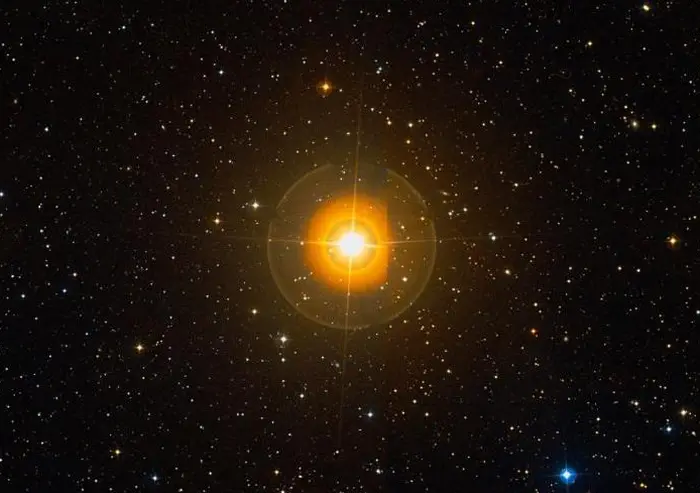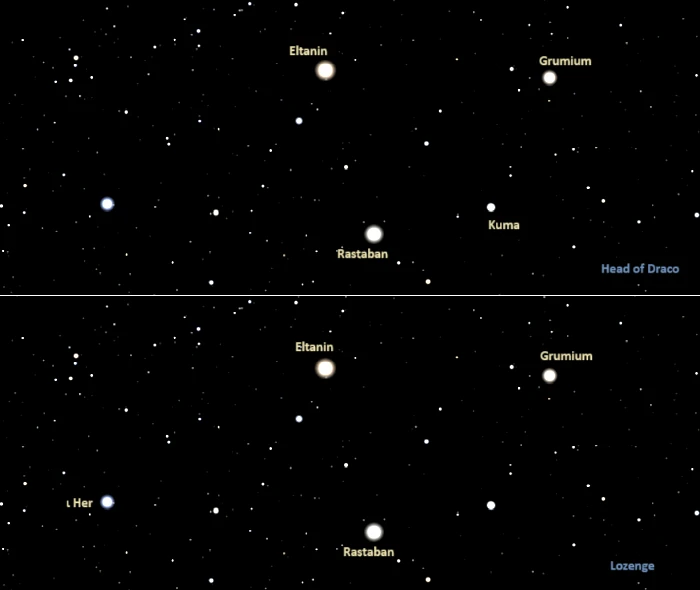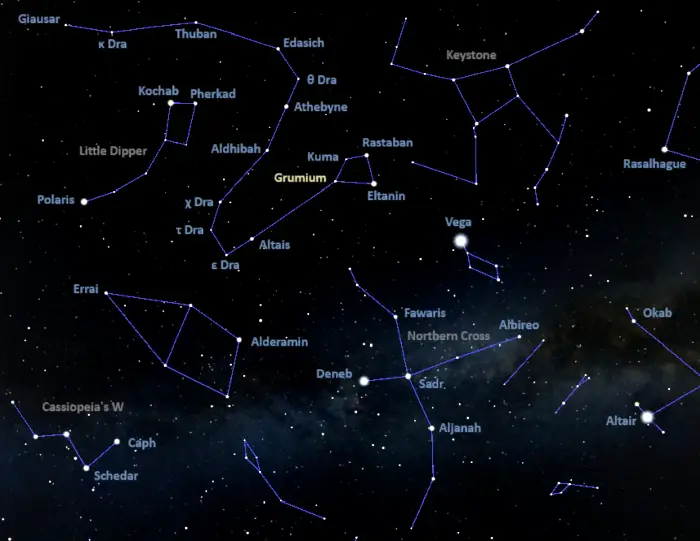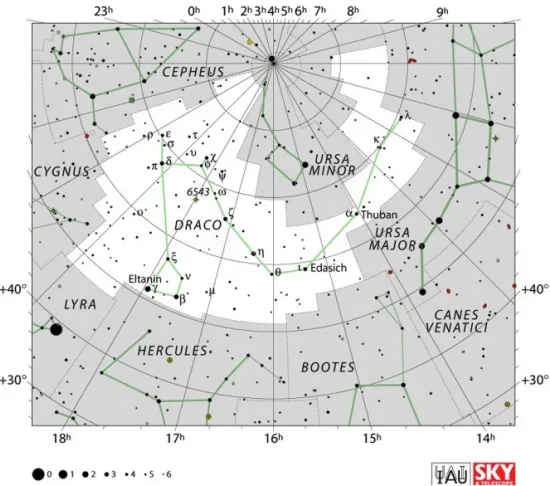Grumium, Xi Draconis (ξ Dra), is a binary star located 112.5 light-years away in the northern constellation Draco. With an apparent magnitude of 3.75, it is visible to the unaided eye. It is one of the four stars that form the head of the celestial Dragon.
Star system
Grumium is an orange giant of the spectral type K2 III. The star’s evolutionary status is uncertain. It may either be on the red giant branch, still fusing hydrogen into helium in shell around the core, or it could be on the horizontal branch and fusing helium into carbon.
The evolved giant star has a mass of 1.45 solar masses. As it left the main sequence behind, it grew to a size of 11.56 solar radii. With an effective temperature of about 4,451 K, the star is 47.30 times more luminous than the Sun. It spins at 2.3 km/s.
Grumium may have a companion, Xi Draconis B, at a separation of 316 arcseconds. The possible companion is a 16th magnitude star and very likely just lies in the same line of sight as Grumium. If the two stars are related, they are separated by at least 11,000 astronomical units and have an orbital period of 800,000 years. However, they are most likely unrelated.

Grumium (Xi Draconis), image credit: ESO/Digitized Sky Survey 2 (CC BY 4.0)
Facts
Shining at magnitude 3.75, Grumium is the ninth brightest star in the large but inconspicuous constellation of Draco. It does not make the list of the 300 brightest stars in the night sky. If not for interstellar extinction, Grumium would be 0.03 magnitudes brighter. The star’s light is obscured by intervening dust and gas.
Grumium forms the head of Draco with Eltanin (Gamma Draconis), Rastaban (Beta Draconis) and Kuma (Nu Draconis). The brighter Eltanin and Rastaban mark the Dragon’s eyes.
Eltanin, Rastaban and Grumium form an asterism called the Lozenge with Iota Herculis in the neighbouring constellation Hercules. Some observers consider the Lozenge to be the same asterism as the head of Draco (with Nu Draconis instead of Iota Herculis).

Head of Draco and Lozenge asterisms, image: Stellarium
In Arabic astronomy, Grumium formed an asterism known as the Mother Camels (Al ʽAwāyd) with Rastaban (Beta Draconis), Eltanin (Gamma Draconis), Alrakis (Mu Draconis), and Kuma (Nu Draconis). The name of the asterism was later translated into Latin as Quinque Dromedarii.
The four stars represented four camels guarding a foal, represented by the fainter Alruba (HIP 86782), from two hyenas (or wolves), represented by Athebyne (Eta Draconis) and Aldhibah (Zeta Draconis).
Name
The name Grumium (pronunciation: /ˈɡruːmiəm/) is a corruption of Grunnum, the Latin word for “snout.” The Greek astronomer Ptolemy described the star as marking the jawbone of the celestial Dragon.
The International Astronomical Union’s (IAU) Working Group on Star Names (WGSN) approved the name on September 12, 2016. The name formally applies only to the primary component, Xi Draconis A, but has traditionally been used for the whole star system.
In traditional Chinese astronomy, Xi Draconis was known as 天棓一 (Tiān Bàng yī), the First Star of Celestial Flail. Celestial Flail was an asterism formed by Grumium with Kuma (Nu Draconis), Rastaban (Beta Draconis), Eltanin (Gamma Draconis), and Iota Herculis. The asterism represented an agricultural device for threshing. It was part of the larger Purple Forbidden Enclosure, which represented the imperial palace.
Xi Draconis was historically also known as Nodus Primus or Nodus I. It marks the first twist of the Dragon’s body.
Location
Grumium is easy to find because it is part of a relatively bright asterism, the head of Draco. The Dragon’s head can be found using the stars of the brighter Northern Cross, a star pattern that dominates the constellation Cygnus (the Swan). A line through the beam of the Cross, drawn from Sadr (Gamma Cygni) through Fawaris (Delta Cygni), leads to Eltanin and Rastaban, the stars that mark the Dragon’s eyes. Grumium is the third brightest star in the Dragon’s head. At declination +56° 52’, it never rises for observers south of the latitude 33° S.

The location of Grumium (Xi Draconis), image: Stellarium
Constellation
Grumium is located in the constellation Draco. Representing the dragon Ladon in Greek mythology, Draco is one of the Greek constellations, catalogued by the Greco-Roman astronomer Claudius Ptolemy in his Almagest in the 2nd century CE. In Greek lore, Ladon guarded the gardens of the Hesperides and met his end at the hands of Heracles.
Draco is the eighth largest constellation in the sky. Stretching across an area of 1,083 square degrees, it is the fourth largest northern constellation, after Ursa Major, Hercules, and Pegasus. Draco is circumpolar to the northern hemisphere; it never falls below the horizon and can be seen throughout the year.
Despite its size, Draco does not stand out in the sky. Eltanin (Gamma Draconis), the constellation’s brightest star, shines at magnitude 2.23 from a distance of 154.3 light-years. Like Grumium, it is a K-type giant, but larger, more massive, and much more luminous.

Draco constellation map by IAU and Sky&Telescope magazine (Roger Sinnott & Rick Fienberg) (CC BY 3.0)
Other relatively bright stars in Draco include the orange giant Edasich (Iota Draconis), the white subgiant Thuban (Alpha Draconis), the yellow giants Athebyne (Eta Draconis), Altais (Delta Draconis) and Omicron Draconis, the blue giant Aldhibah (Zeta Draconis), the yellow supergiant or bright giant Rastaban (Beta Draconis), and the multiple star system Mu Draconis (Alrakis).
Deep sky objects in Draco include the Spindle Galaxy (Messier 102, NGC 5866), the Tadpole Galaxy (Arp 188), the Draco Dwarf, the Splinter Galaxy (NGC 5907), the Cat’s Eye Nebula (NGC 6543), the Dolphin Galaxy (NGC 6670) and the Draco Trio of galaxies.
The best time of the year to observe the stars and deep sky objects in Draco is in the month of July, when the constellation appears higher above the horizon in the early evening. The entire constellation is visible from locations north of the latitude 15° S.
The 10 brightest stars in Draco are Eltanin (Gamma Dra, mag. 2.23), Athebyne (Eta Dra, mag. 2.73), Rastaban (Beta Dra, mag. 2.79), Altais (Delta Dra, mag. 3.07), Aldhibah (Zeta Dra, mag. 3.17), Edasich (Iota Dra, mag. 3.29), Chi Draconis (mag. 3.57), Thuban (Alpha Dra, mag. 3.6452), Grumium (Xi Dra, mag. 3.75), and Giausar (Lambda Dra, mag. 3.85).
Grumium – Xi Draconis
| Spectral class | K2 III |
| U-B colour index | +1.21 |
| B-V colour index | +1.18 |
| Apparent magnitude | 3.75 |
| Absolute magnitude | +1.06 |
| Distance | 112.5 ± 0.5 light-years (34.5 ± 0.1 parsecs) |
| Parallax | 29.0603 ± 0.1155 mas |
| Radial velocity | −26.09 ± 0.37 km/s |
| Proper motion | RA: 93.698 ± 0.153 mas/yr |
| Dec.: 78.914 ± 0.145 mas/yr | |
| Mass | 1.45 ± 0.17 M☉ |
| Luminosity | 47.30 ± 0.44 L☉ |
| Radius | 11.56 ± 0.06 R☉ |
| Temperature | 4,451 ± 7 K |
| Metallicity | -0.09 dex |
| Rotational velocity | 2.3 km/s |
| Surface gravity | 2.3 cgs |
| Constellation | Draco |
| Right ascension | 17h 53m 31.7295427958s |
| Declination | +56° 52′ 21.510944948″ |
| Names and designations | Grumium, Xi Draconis, Xi Dra, ξ Draconis, ξ Dra, 32 Draconis, 32 Dra, HD 163588, HR 6688, HIP 87585, BD+56 2033, AG+56 1133, FK5 671, SAO 30631, GC 24364, GCRV 10361, IRC +60253, N30 3981, PPM 36240, PLX 4093, SKY# 32410, RAFGL 2026, GEN# +1.00163588, JP11 2902, GSC 03910-01710, ROT 2507, PMC 90-93 477, UBV 15249, UBV M 22485, IRAS 17526+5652, 2MASS J17533173+5652216, TD1 21275, TIC 232621005, USNO 874, WEB 14775, YZ 56 9517, TYC 3910-1710-1, Gaia DR2 1421593566061407872, Gaia DR3 1421593566062037120, LDS 1457A, CCDM J17535+5653A, IDS 17519+5654 A, WDS 17535+5652A |